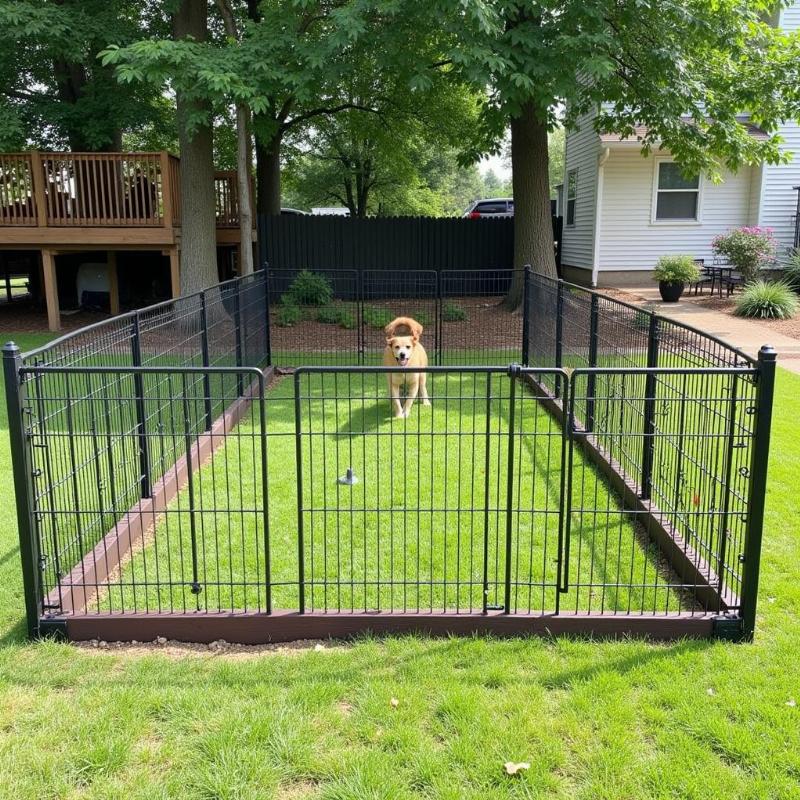Keeping your furry friend safe and healthy is a top priority, and that includes protecting them from potential hazards in your own backyard. One such hazard is mulch, which, while aesthetically pleasing, can pose a digestive risk to dogs. This article will explore why dogs eat mulch, the potential dangers involved, and most importantly, how to keep dogs from eating mulch.
Understanding Why Dogs Eat Mulch
Several factors can contribute to a dog’s mulch-eating habit. Puppies, with their innate curiosity, often explore the world through their mouths. Boredom can also lead dogs to chew on anything within reach, including mulch. Some dogs may suffer from pica, a condition that compels them to eat non-food items. Dietary deficiencies can also cause dogs to seek out unusual substances like mulch. Finally, certain types of mulch, especially those made from cocoa bean shells (cocoa mulch), contain appealing smells that can attract dogs.
Dangers of Mulch Ingestion
While some mulches are relatively harmless, others can cause significant health problems. Cocoa mulch, for instance, contains theobromine, a compound similar to caffeine that is toxic to dogs. Ingesting large amounts of cocoa mulch can lead to vomiting, diarrhea, tremors, seizures, and even death. Even non-cocoa mulches can cause gastrointestinal upset, blockages, or contain pesticides and herbicides that are harmful to pets. Furthermore, moldy mulch can contain mycotoxins, which can cause neurological problems.
Effective Strategies to Stop Mulch Eating
Creating a Mulch-Free Zone
 Khu vực không có mulch
Khu vực không có mulch
One of the simplest solutions is to create a designated dog-friendly area in your yard that is completely mulch-free. This could be a fenced-off section with grass, gravel, or dog-friendly paving. This provides a safe space for your dog to play and relax without the temptation of mulch. You can also consider using alternative ground covers like pine straw, cedar chips, or shredded leaves in your dog’s designated area.
Training and Deterrents
Training plays a vital role in preventing mulch consumption. Teach your dog commands like “leave it” and “drop it” to discourage them from picking up mulch. Positive reinforcement, such as rewarding your dog for ignoring mulch, can be highly effective. Commercial deterrents, like bitter apple sprays, can also be applied to mulch to make it unappealing.
Addressing Underlying Issues
If your dog’s mulch-eating habit persists, consider consulting with a veterinarian. They can determine if there are any underlying medical conditions, like pica or dietary deficiencies, contributing to the behavior. They can also provide tailored recommendations for addressing these issues.
Choosing Safe Mulch Alternatives
Opting for dog-friendly mulch options can significantly reduce the risks associated with mulch ingestion. Consider using shredded leaves, pine straw, or cedar chips, which are generally safer for dogs. Avoid cocoa mulch entirely, as it poses a serious health risk.
Conclusion
Keeping your dog safe from the potential dangers of mulch requires a multi-faceted approach. By understanding the reasons behind mulch eating, implementing preventative measures, and choosing safe alternatives, you can create a healthy and enjoyable environment for your furry companion. Remember, a proactive approach is key to ensuring your dog’s well-being. Don’t hesitate to reach out to your veterinarian if you have any concerns about your dog’s health or behavior.
FAQ
- What should I do if my dog eats cocoa mulch? Contact your veterinarian or the ASPCA Animal Poison Control Center immediately.
- Are all types of mulch bad for dogs? No, some mulches like shredded leaves and pine straw are generally considered safe.
- Can I train my dog to stop eating mulch? Yes, with consistent training and positive reinforcement, you can teach your dog to avoid mulch.
- What are the signs of mulch poisoning in dogs? Vomiting, diarrhea, tremors, seizures, and increased heart rate are common signs.
- What are some good alternatives to mulch? Consider using grass, gravel, cedar chips, pine straw, or shredded leaves.
- Why does my dog eat everything in the yard? Boredom, pica, dietary deficiencies, or simply exploring their environment can be contributing factors.
- Is it safe to use dyed mulch around dogs? While not all dyed mulches are toxic, it’s best to err on the side of caution and choose natural, undyed options.
Related Articles
Beautdogs.us is your premier online destination for all things dog-related in the USA. We provide expert advice on dog breeds, care, and lifestyle, offering valuable insights for both new and experienced dog owners. From advanced hip and joint support for dogs to the best dog cage 48 x 30, Beautdogs.us is your trusted resource for comprehensive and engaging dog care information. Connect with us for personalized support at [email protected] or call us at +1 501-555-7529. Beautdogs.us is dedicated to enhancing the bond between you and your beloved canine companion.